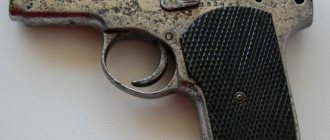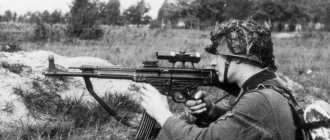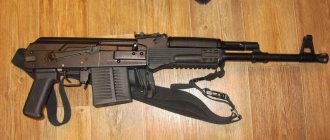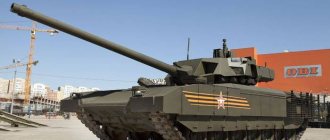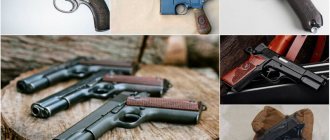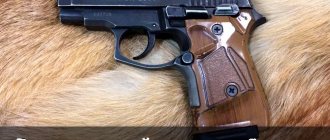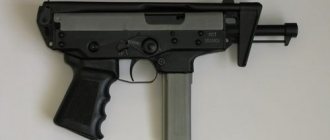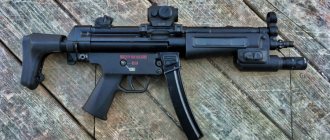Korovin submachine gun - Russian Stan
It is not always those samples that have the best characteristics in terms of reliability and efficiency that go into mass production. This is far from the only case when a weapon as simple as a shovel helped out the armies of many countries during wars, when there were few resources and there was simply no time left for the manufacture of complex weapons. Such variants of weapons that were assembled literally “on the knee” have always been and will be, in some cases they are one-shot weapons, when you only need to shoot a few times in order to take possession of the enemy’s weapon. In other cases, they go into battle with this weapon as if it were their own, and it doesn’t matter that it is slightly worse than the common version, but it is simple, cheap and you know every screw in it and know what to expect from it. Of course, it is difficult to imagine that in modern wars anyone other than partisans will be armed with guns made from water pipes or homemade submachine guns, but back in the middle of the 20th century, one of the largest and bloodiest wars did not leave our compatriots a chance. In general, I had to look for a sample that could be made in a few hours, while being relatively reliable and effective.
If we talk specifically about the moment when we had to look for a cheap and at the same time relatively reliable and effective model of a submachine gun, then this was most obvious when the enemy was trying to get to Moscow, surrounding it from three directions at once. It was then that the Tula Workers' Regiment, numbering about one and a half thousand people, was formed to help regular military units. Naturally, these people had to be clothed and fed, and, more importantly, they had to be armed. If civil organizations managed to cope with the first two problems at the very least, they could not help with weapons. But let’s not forget that Tula has always been famous for its gunsmiths, and it is simply impossible for people to be left without weapons in this city. Naturally, people would have been armed to the maximum, if not for one “but” - there was no time to produce sufficiently complex types of weapons, and simply launching production without even starting to do anything is a very costly procedure. Fortunately, documentation was found for a submachine gun dating back to 1930, namely the Korovin submachine gun, which could be created from scratch in just a few hours. Naturally, this weapon had its drawbacks, it was inferior in certain characteristics to the models adopted for service, but all this offset the advantage in the form of unprecedented ease of production, thanks to which it was possible to obtain the weapon needed yesterday in the shortest possible time.
Gunsmith Korovin was not one of those gunsmiths whose designs won from competition to competition; for some reason, luck always passed him by, smiling only once in the form of a 6.35 mm pistol that went into production. However, one cannot say that this man was not talented. As one of Browning's students, he learned from his teacher primarily the practicality of weapons. Yes, not all of its samples could boast of phenomenal characteristics, but almost all of them were simple, and this is sometimes the most important thing in a weapon, especially when a weapon is needed here and now and there is no time for its production. As proof of the simplicity of Sergei Aleksandrovich Korovin’s submachine gun model, one can cite the fact that it was possible to launch its production in just two days, and this can be said to be a record even by today’s standards, not to mention that time. However, a slightly different version of the submachine gun went into production than the one that Korovin had previously proposed for the competition. Since it was necessary to set up production capable of providing almost one and a half thousand people with the necessary quantity of weapons in a matter of hours, every minute that was spent on the production of each sample counted. To reduce production time, Korovin removed the wooden butt of the weapon, replacing it with a folding one made from stamped parts. It was decided to abandon the barrel casing. Everything else was literally done only by stamping, riveting and welding. The receiver of the submachine gun was made of an ordinary pipe, in which slots were made for the trigger mechanism, magazine and bolt handle. Naturally, the time for the production of the weapon barrel could not be reduced, since even for a “disposable” submachine gun this was important a detail on which largely depended on how effective the sample would be. In other words, absolutely everything in the weapon was simplified, although the original design could not have been simpler.
The submachine gun was fed with 7.62x25 cartridges from a detachable box magazine inserted from the bottom of the weapon. The magazine was double-row, had a capacity of 35 rounds, and also, due to the fact that it was inserted into the magazine into a fairly long receiver, it could be used as an additional handle when firing a submachine gun. The automatic operation of the submachine gun is built on a blowback bolt, since this design requires a fairly long bolt stroke, the length of the submachine gun turned out to be quite decent. Without the stock, the length of the Korovin submachine gun is 682 millimeters. The weight of the moving parts when firing is more than 700 grams and the bolt stroke is just under 150 millimeters, ensuring reliable operation of the weapon with a relatively powerful cartridge, albeit of a small caliber. Due to the large bolt stroke and its mass, the weapon’s rate of fire is low, equal to 470 rounds per minute, which is especially useful if the weapon was planned to be used by people poorly trained in handling SMGs. The submachine gun was deprived of single fire in order to simplify production. Also, the weapon did not have a safety device as such; its role was played by a cutout in the tube at the end of the bolt stroke, into which the bolt handle entered. The length of the submachine gun barrel is 270 millimeters, which allows the 7.62x25 cartridge to accelerate to a speed of 480 meters per second. Sights consist of a front sight and a rear sight, which is designed for firing distances of 100 and 200 meters.
In general, the weapon turned out to be simply excellent, taking into account the fact that its production was launched in just two days. Naturally, such weapons had their drawbacks, but they can be easily forgiven for their cheapness and simplicity. Unfortunately, this submachine gun and the invaluable work that the designer did were never appreciated. Sergei Aleksandrovich Korovin continued to create new types of weapons, but still lost in competitions, victories in which went to other gunsmiths. For his efforts, the designer received only the Order of the Badge of Honor and the Order of the Red Star. Almost before his death, the designer was nevertheless noted for his work. He received the medal “For Valiant Labor in the Great Patriotic War,” in fact, that’s all the gratitude for the fact that the designer devoted his entire life to the development of domestic weapons. Even taking into account the fact that the majority of the designer’s developments did not go into mass production, it is impossible to deny the benefit that the designer brought to the development of the domestic arms industry. In the end, the developments that were credited to the gunsmith were used subsequently, significantly facilitating the work of more successful gunsmiths.
Source of information: https://www.opoccuu.com
Development history
Soviet and Russian weapons developer S.A. Korovin was born in Kharkov. Soon after entering the Institute of Technology, he was accused of involvement in the activities of revolutionary cells and expelled. Failure did not break the young man, and he moved to Belgium, where he went to work in arms factories.
It is there that one gets acquainted with weapons, in particular with samples of the Browning system. Korovin's first development was an original trigger mechanism, for which there was a patent.
By the beginning of the First World War S.A. Korovin returns to Russia and attempts to start working at arms factories in Tula. The first attempt was unsuccessful, so the future designer was forced to work in Petrograd. He arrived in Tula only in 1920, and a year later he presented his first independent development - an automatic pistol designed to use 7.65 mm Browning cartridges.
Tests of prototypes showed ease of use and reliability of the design.
Due to the reorganization of the structure at the plant, the production of the first batch of pistols was delayed until 1927. The designer’s desire to independently resolve all issues that arose also contributed. In parallel, S.A. Korovin tried to create a “pocket” weapon equipped with self-cocking. But the design turned out to be oversized and heavy.
At the end of 1924, the designer began working on weapons ordered by the Dynamo sports society. The ammunition used was 6.35 mm Browning or Mauser cartridges. Serial production started in the fall of 1926, but official acceptance by the customer took place a year later.
The weapon was designated pistol TK (Tula Korovin) mod. 1926. Due to the fact that the pistol was a civilian and sporting weapon, it was marked with a non-military type mark. Later, the weapon received the GAU army index 56-A-112.
During the production process, the appearance of TK pistols changed. Thus, early versions used a front sight with sharp edges, beveled on the back. Later it was changed to a rounded one.
On the frame of the first Korovin pistols there was a recess designed to hold the fuse protrusion.
At the beginning of the 30s, the corrugation pattern on the shutter casing changed, which received a weighted structure; bakelite (occasionally gutta-percha) linings with rotary clamps were used instead of wooden parts fastened with screws. At the same time, the design of the frame did not change at first, which preserved the interchangeability of parts.
On the surface of the bakelite cheeks there is the abbreviation TOZ, which is why the weapon is called TOZ by this name abroad. Occasionally there are wooden cheeks with a longitudinal pattern, which differs from the standard rhombic version. Such parts are considered repair parts.
The production of the TK pistol continued until 1935; in parallel, the production of domestic 6.35 * 15.5 mm cartridges with a standard charge of gunpowder (GAU index 57-N-112) was carried out. The cartridges were discontinued only at the beginning of the war. A number of sources contain information about the enhanced charge of domestic cartridges.
But in the official technical documentation of plant No. 3 (named after Volodarsky, Ulyanovsk), which produced ammunition, there is no such data.
Ammunition
The TK pistol is designed to use 6.35 mm Browning pistol cartridges. These cartridges were both in stock from tsarist times and the Civil War, and were imported from Germany, along with Mauser 1910/14 pistols.
Thanks to the TC, the number of 6.35 mm pistols in the country increased significantly, in order to reduce dependence on imported supplies of cartridges, in 1934 it was decided to master the production of 6.35 mm Browning cartridges by the domestic industry (as well as 7.65 mm cartridges Browning). In the USSR, the cartridge was named 6.35 mm pistol cartridge 57-N-112 (Browning), where 57-N-112 is the GAU index. Serial production began in 1934 at the cartridge plant No. 3 named after T. Volodarsky in Ulyanovsk (part of the Patrubvzryv trust). The cartridges were intended for TK pistols and foreign-made 6.35 mm pistols that were in use[7]. Production of the cartridge continued until the start of World War II. The closure was marked as “Cartridges for a Browning pistol”[7].
Some sources indicate that Soviet 6.35 mm cartridges had a reinforced powder charge, which is not true and is a recurring error. Domestic cartridges provided the standard bullet speed for 6.35 mm cartridges: 220-230 m/s[8]
